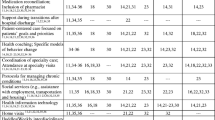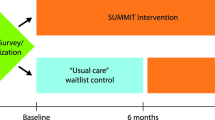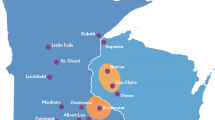Abstract
We sought to examine the literature using the Patient Activation Measure (PAM) or the Patient Enablement Instrument (PEI) with high-need, high-cost (HNHC) patients receiving care in urban safety net settings. Urban safety net care management programs serve low-income, racially/ethnically diverse patients living with multiple chronic conditions. Although many care management programs track patient progress with the PAM or the PEI, it is not clear whether the PAM or the PEI is an effective and appropriate tool for HNHC patients receiving care in urban safety net settings in the United States. We searched PubMed, EMBASE, Web of Science, and PsycINFO for articles published between 2004 and 2015 that used the PAM and between 1998 and 2015 that used the PEI. The search was limited to English-language articles conducted in the United States and published in peer-reviewed journals. To assess the utility of the PAM and the PEI in urban safety net care settings, we defined a HNHC patient sample as racially/ethnically diverse, low socioeconomic status (SES), and multimorbid. One hundred fourteen articles used the PAM. All articles using the PEI were conducted outside the U.S. and therefore were excluded. Nine PAM studies (8%) included participants similar to those receiving care in urban safety net settings, three of which were longitudinal. Two of the three longitudinal studies reported positive changes following interventions. Our results indicate that research on patient activation is not commonly conducted on racially and ethnically diverse, low SES, and multimorbid patients; therefore, there are few opportunities to assess the appropriateness of the PAM in such populations. Investigators expressed concerns with the potential unreliability and inappropriate nature of the PAM on multimorbid, older, and low-literacy patients. Thus, the PAM may not be able to accurately assess patient progress among HNHC patients receiving care in urban safety net settings. Assessing progress in the urban safety net care setting requires measures that account for the social and structural challenges and competing demands of HNHC patients.

Similar content being viewed by others
References
Cohen SB and Yu W. Statistical Brief #354: the Concentration and Persistence in the Level of Health Expenditures over Time: Estimates for the U.S. Population, 2008–2009. 2012, Agency for Healthcare Research and Quality: Rockville, MD.
Gawande A. The Hot Spotters: Can We Lower Medical Costs by Giving the Neediest Patients Better Care?, in The New Yorker. 2011.
Blumenthal D, et al. Caring for high-need, high-cost patients—an urgent priority. N Engl J Med. 2016;375(10):909–11.
Hong CS, Abrams MK, Ferris TG. Toward increased adoption of complex care management. N Engl J Med. 2014;371(6):491–3.
Kronick, R.G., et al.. The Faces of Medicaid III: Refining the Portrait of People with Multiple Chronic Conditions. 2009, Center for Health Care Strategies, Inc.: Hamilton, NJ.
Hibbard JH, Cunningham PJ. How engaged are consumers in their health and health care, and why does it matter? Res Brief. 2008;8:1–9.
Hibbard JH, et al. Taking the long view: how well do patient activation scores predict outcomes four years later? Med Care Res Rev. 2015;72(3):324–37.
Hibbard JH, et al. Development of the Patient Activation Measure (PAM): conceptualizing and measuring activation in patients and consumers. Health Serv Res. 2004;39(4 (Pt 1)):1005–26.
Hibbard JH, et al. Development and testing of a short form of the patient activation measure. Health Serv Res. 2005;40(6 Pt 1):1918–30.
Howie JGR, et al. A comparison of a Patient Enablement Instrument (PEI) against two established satisfaction scales as an outcome measure of primary care consultations. Fam Pract. 1998;15(2):165–71.
Porter A. The development of process and outcome measures for general practice consultations. Occas Pap R Coll Gen Pract. 1997;75:31–2.
Harris LJ, et al. Characteristics of hospital and emergency care super-utilizers with multiple chronic conditions. J Emerg Med. 2016;50(4):e203–14.
Johnson TL, et al. For many patients who use large amounts of health care services, the need is intense yet temporary. Health Aff (Millwood). 2015;34(8):1312–9.
Multiple Chronic Conditions—A Strategic Framework: Optimum Health and Quality of Life for Individuals with Multiple Chronic Conditions. 2010, U.S. Department of Health & Human Services: Washington, DC.
Burwell SM. Annual Update on the HHS Poverty Guidelines, Office of the Secretary, Department of Health and Human Services, Editor. 2015.
Cabassa LJ, et al. Primary health care experiences of Hispanics with serious mental illness: a mixed-methods study. Adm Policy Ment Health Ment Health Serv Res. 2014;41(6):724–36.
Crowley MJ, et al. Factors associated with persistent poorly controlled diabetes mellitus: clues to improving management in patients with resistant poor control. Chronic Illness. 2014;10(4):291–302.
Dattalo M, et al. Who participates in chronic disease self-management (CDSM) programs? Differences between participants and nonparticipants in a population of multimorbid older adults. Med Care. 2012;50(12):1071–5.
Druss BG, et al. The health and recovery peer (HARP) program: a peer-led intervention to improve medical self-management for persons with serious mental illness. Schizophr Res. 2010;118(1–3):264–70.
Druss BG, et al. Randomized trial of an electronic personal health record for patients with serious mental illnesses. Am J Psychiatry. 2014;171(3):360–8.
Evangelista LS, et al. Examining the effects of remote monitoring systems on activation, self-care, and quality of life in older patients with chronic heart failure. J Cardiovasc Nurs. 2015;30(1):51–7.
Kawi J. Predictors of self-management for chronic low back pain. Appl Nurs Res. 2014;27(4):206–12.
Maeng DD, et al. Care coordination for the chronically ill: understanding the patient’s perspective. Health Serv Res. 2012;47(5):1960–79.
Skolasky RL, et al. Psychometric properties of the patient activation measure among multimorbid older adults. Health Serv Res. 2011;46(2):457–78.
Ryvicker M, et al. The role of patient activation in improving blood pressure outcomes in Black patients receiving home care. Med Care Res Rev. 2013;70(6):636–52.
Ryvicker M, Peng TR, Feldman PH. Patient activation and disparate health care outcomes in a racially diverse sample of chronically ill older adults. J Health Care Poor Underserved. 2012;23(4):1577–89.
Schmaderer M, et al. Psychometric properties of the patient activation measure in multimorbid hospitalized patients. J Nurs Meas. 2015;23(3):128–41.
Hibbard JH, et al. Improving Population Health Management Strategies: Identifying Patients Who Are More Likely to Be Users of Avoidable Costly Care and Those More Likely to Develop a New Chronic Disease. Health Serv Res, 2016.
Hibbard JH, Greene J. What the evidence shows about patient activation: better health outcomes and care experiences; fewer data on costs. Health Aff (Millwood). 2013;32(2):207–14.
McVey S. Insignia Health Earns ‘Best in Class’ Endorsement from National Quality Forum for a Person and Family-Centered Care Measure. June 6, 2016 Insignia Health. Portland, OR.
The World’s Leading Patient Self-Management Model Is Now Backed by over 300 Peer-Reviewed Published Studies. January 17, 2017, Insignia Health. Portland, OR.
Patient Activation Measure (PAM) Named in MACRA as a Tool to Help an Estimated 600,000 Health Professionals Improve Clinical Care and Health Outcomes for Medicare Patients. December 14, 2016: Insignia Health. Portland, OR
NY State Medicaid Program Invests in Patient Activation Tools to Reduce Costs by 25%. April 13, 2016: Insignia Health. Portland, OR.
New York State Department of Health: Delivery System Reform Incentive Payment (DSRIP) Program. Available from: https://www.health.ny.gov/health_care/medicaid/redesign/dsrip/. Accessed 2017 February 13.
Washington State’s Health Homes Program Saves $21.6 Million Focusing on Health Activation. May 12, 2016: Insignia Health.
Nearly Two Million Patients to Receive Person-Centred Support to Manage Their Own Care. NHS England April 2016 [cited 2017 February 13]; Available from: https://www.england.nhs.uk/2016/04/person-centred-support/.
Armstrong, N., et al.. Independent Evaluation of the Feasibility of Using the Patient Activation Measure in the NHS in England: Summary Interim Report. 25 April 2016, University of Leicester. Leicester, England.
Acknowledgements
This research was supported by the National Institutes of Health (NR015233-01). The authors thank the UCSF Education & Copyright Librarians, Peggy Tahir, MLIS, MA and Evans (Whit) Whitaker, MD, MLIS for their assistance with the search methods.
Author information
Authors and Affiliations
Corresponding author
Ethics declarations
Funding
This work was supported by the National Institutes of Health (NIH NR015233-01).
Additional information
As of May 1, 2017, E. Davis can be reached at the Department of Medicine, Rush University, 1700 W. Van Buren 5th Floor, Chicago IL, 60612. elizabeth_davis@rush.edu.
Rights and permissions
About this article
Cite this article
Napoles, T.M., Burke, N.J., Shim, J.K. et al. Assessing Patient Activation among High-Need, High-Cost Patients in Urban Safety Net Care Settings. J Urban Health 94, 803–813 (2017). https://doi.org/10.1007/s11524-017-0159-9
Published:
Issue Date:
DOI: https://doi.org/10.1007/s11524-017-0159-9




